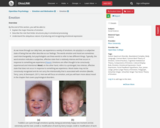
- Subject:
- Social Science
- Material Type:
- Full Course
- Provider:
- Rice University
- Provider Set:
- OpenStax College
- Date Added:
- 02/14/2014



By the end of this section, you will be able to:
Explain the major theories of emotion
Describe the role that limbic structures play in emotional processing
Understand the ubiquitous nature of producing and recognizing emotional expression

The Public Speaking course was developed through the Ohio Department of Higher Education OER Innovation Grant. This work was completed and the course was posted in September 2019. The course is part of the Ohio Transfer Assurance Guides and is also named OCM013. For more information about credit transfer between Ohio colleges and universities, please visit: www.ohiohighered.org/transfer.Team LeadJessica Papajcik Stark State College Content ContributorsJames Jarc Central Ohio Technical CollegeJanny Nauman North Central State CollegeCarrie Tomko University of Akron LibrarianAllen Reichert Otterbein UniversityReview TeamLaura Garcia Washington State Community CollegeJasmine Roberts Ohio State University


Scholars and practitioners agree that between 50-65% of the information that we communicate with others is done through nonverbal channels... That is, all of the ways that we communicate without using words. Whether it’s a smile or a smirk; eye contact and a nod; gestures, or touch...they all send a message. This section introduces students to the ways in which nonverbal communication is used at an interpersonal level as well as in the public speaking context. As public speakers, students will learn to use nonverbal communication to develop rapport with their audience, to demonstrate confidence and competence, and to deliver clear, engaging, and memorable speeches. Developing strong nonverbal communication habits takes practice, and this chapter includes educational activities designed to help students hone their skills. When used effectively, nonverbal communication can support the words that are being said and improve the effectiveness of the message. When used poorly, nonverbal cues can confuse the audience, or worse, may send the message that the speaker is unprepared, uninterested, or even deceitful. This section provides information that will help students understand the best ways to use nonverbal techniques to become a more confident and engaging presenter.